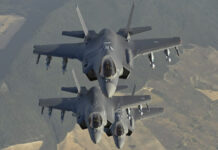Boeing and Northrop Grumman submitted this week their competing bids for the US Air Force’ KC-135 tanker replacement program (KC-X).
Boeing’s 7,000-page proposal describes a tanker uniquely designed for its primary air refueling mission, but also capable of moving cargo, passengers, patients and medical crewmembers.
The Boeing Global Tanker Team producing the KC-767 Advanced Tanker includes Smiths Aerospace, Rockwell Collins, Vought Aircraft Industries, Honeywell, Pratt & Whitney and Spirit AeroSystems. The experienced team has proven expertise in aerial refueling systems, network centric operations, integrated avionics solutions and lean manufacturing concepts.
The KC-30 proposal submission represents over two and-a-half years developmental effort, by the Northrop Grumman-led KC-30 Tanker Team comprising a global group of companies including Northrop Grumman, EADS, General Electric, Sargent Fletcher and Honeywell.
Both teams highlight the vision and long term benefits of the new tanker, which will compensate for the huge acquisition cost or the tanker fleet replacement. “The competition to build the KC-X is as much a competition of vision as it is of aircraft,” said Scott J. Seymour, corporate vice president and president of Northrop Grumman Integrated Systems sector. “The KC-767 Advanced Tanker will do for refueling what the C-17 has done for airlift – it will revolutionize mobility operations,” said James Albaugh, president and CEO, Boeing Integrated Defense Systems. “Right-sized to enable access to 1,000 more bases than the KC-135, this robust aircraft allows commanders to deploy more tankers, ensures more booms are in the sky, covers more refueling orbits and offloads more fuel.”
The KC-X program will be worth $30-40 billion. The projected life cycle cost of the new tankers has been estimated at $200 billion. The Air Force plans spending about $8.2 billion until 2010 on development and testing, and expects the first squadron of 16 aircraft to become operational by 2013.
Based on a new version of the 767-200 Long Range Freighter, Boeing’s KC-767 Advanced Tanker’s innovations include an advanced fly-by-wire boom, new wing refueling pods, a centerline hose drum refueling unit, an advanced commercial digital flight deck and a third-generation remote vision refueling system. Boeing stresses the ‘all American’ base of its aircraft which will be designed, built and supported by 44,000 Americans and 300 U.S. suppliers. They also argue that their aircraft is more fuel efficient, and is expected to save about $10 billion in fuel costs, compared to the KC-30. Boeing plans to produce the tanker at its facilities in Everett, Washington, on the existing 767 commercial production line. Installation of military refueling systems and flight test activities will take place at the company’s finishing center in Wichita, Kansas.
Northrop Grumman highlights the added benefits provided by the larger A330 platform. “The KC-30 Tanker will provide our Air Force leaders and combatant commanders everything they have asked for in air-to-air refueling and more.” Northrop Grumman’s KC-30 Tanker carries 45,000 more pounds of fuel than a KC-135, providing a significant boost to the U.S. Air Force’s global reach. The KC-30 is also designed to refuel Navy and coalition aircraft, and to serve as a multi-role transport aircraft to move passengers, cargo and medical evacuation patients. The KC-30 incorporates defense systems, precision fly-by- wire technology, and the ability to integrate a communications suite and a global support network. “Northrop Grumman and its KC-30 Tanker Team are in this competition to win it.” Said Seymour. Based on the commercially available Airbus A330 platform, KC30 will be assembled in Mobile, Ala. This platform was selected in the last three worldwide tanker competitions to support the air forces of Australia, the United Kingdom and the United Arab Emirates.



















